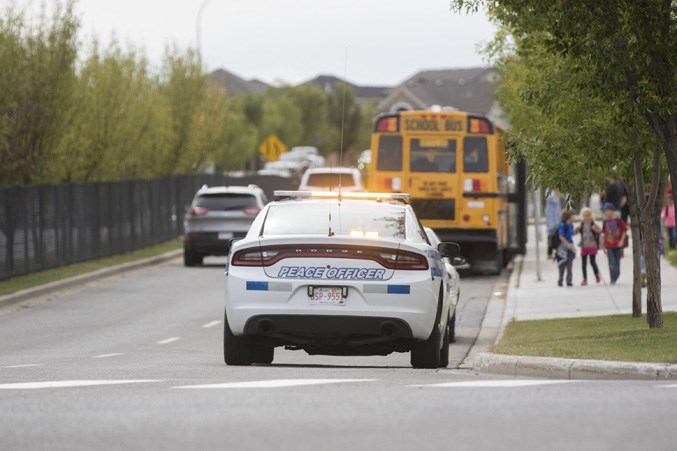School is back in session and that means drivers need to be cautious when driving around school zones or buses in the community. All school zones in Okotoks are back in effect, with speed limits of 30 km/h between the hours of 7:30 a.m. and 5 p.m.
School is back in session and that means drivers need to be cautious when driving around school zones or buses in the community.
All school zones in Okotoks are back in effect, with speed limits of 30 km/h between the hours of 7:30 a.m. and 5 p.m. on school days. However, it’s not just marked zones where drivers should be vigilant – there are many intersections used by students walking to school and bus stops are scattered throughout town.
Kelly Stienwand, Okotoks Municipal Enforcement manager, said it’s important for parents and other drivers to always be aware on the road.
“Kids are excited and although we always need to use extra caution around school zones and playground zones, it’s really important in the first few weeks of school when kids are excited to be reconnecting with their friends and can often be distracted and running out onto the street or hurrying across an intersection,” said Stienwand.
School zones
It may take a minute or two longer to make the morning or afternoon commute, but safety must always come first, said Stienwand.
Speeding in a school zone is one of the offences peace officers and RCMP officers take very seriously, he said. The Traffic Safety Act, section 115, indicates fines range from $105 to $170 on average, depending on the amount of speed, he said.
“However, it’s certainly not our goal to be writing tickets,” said Stienwand. “Our goal is to be present and encourage people to slow down and try to provide the safest environment we can for our kids around school zones.”
Sometimes it can be enough for patrol cars to be parked in the area, he said. Often drivers will be seen taking a look at their speed when they notice an OME or RCMP car in a school zone and there is a noticeable adjustment made, he said.
Being present near schools is a good reminder for drivers to slow down and pay attention to their speed and re-establish good driving habits, he said.
“We know our presence can slow people down and remind people to use extra caution,” said Stienwand.
Pedestrian safety
Caution doesn’t end in the school zone.
In Okotoks, many students – with or without their parents or guardians – walk to school, and that can make for busy intersections in the morning and afternoon, he said.
Some drivers are unaware of how yielding to a pedestrian works, he said.
“If a pedestrian enters a crosswalk and they’re going to cross your pathway, you need to stop and allow them to cross first,” said Stienwand. “Once the pedestrian has crossed in front of your vehicle and you’re clear, and you no longer have to yield to that pedestrian, you can then enter the intersection.”
Stienwand said officers prefer to see someone make it completely across an intersection before vehicles proceed to turn behind them, for safety. Turning into the intersection while someone is still crossing is risky, he said.
“It’s also not necessarily yielding and it could be potentially dangerous,” he said.
When there is a median, the recommendation would be to wait until pedestrians have passed the centre median and are crossing the other lanes, because at that point the driver is no longer yielding to those pedestrians and it is safe, he said.
School buses
Like pedestrian safety, there are rules around stopping for school buses that some drivers are not aware of, said Stienwand.
Any time a school bus pulls over with its yellow lights flashing, it is indicating its intent to pull over to pick up or drop off children, and that’s when drivers should start using caution, he said.
As children are about to board or disembark the bus, the driver will turn on the red flashing lights and put out its stop sign, he said.
“You must come to a stop and you have to wait until the stop sign is no longer deployed before you can advance,” said Stienwand.
The one exception to the rule is when there is a median or boulevard separating a driver from a bus travelling in the opposite direction, he said.
In that case, drivers are not obligated to stop, he said.
“However, we always encourage motorists to slow down, and I see it all the time,” said Stienwand. “I see people coming to a stop on the other side of the boulevard. We’re not going to tell people they shouldn’t so that, but we can say they’re not obligated to.”
Whether a driver on the other side of a median stops or not, he said it’s always a good idea to slow down near the bus because children can be unpredictable.
The most important thing for drivers to remember is to pay attention, he said.
“Having that situational awareness, knowing there’s a bus across the street that’s picking up kids or dropping kids off with its red flashing lights on, just to really be heads-up and to use caution as they’re travelling through that area,” said Stienwand.




